coolant level BMW X5 4.4I 2001 Owners Manual
[x] Cancel search | Manufacturer: BMW, Model Year: 2001, Model line: X5 4.4I, Model: BMW X5 4.4I 2001Pages: 223, PDF Size: 2.66 MB
Page 12 of 223
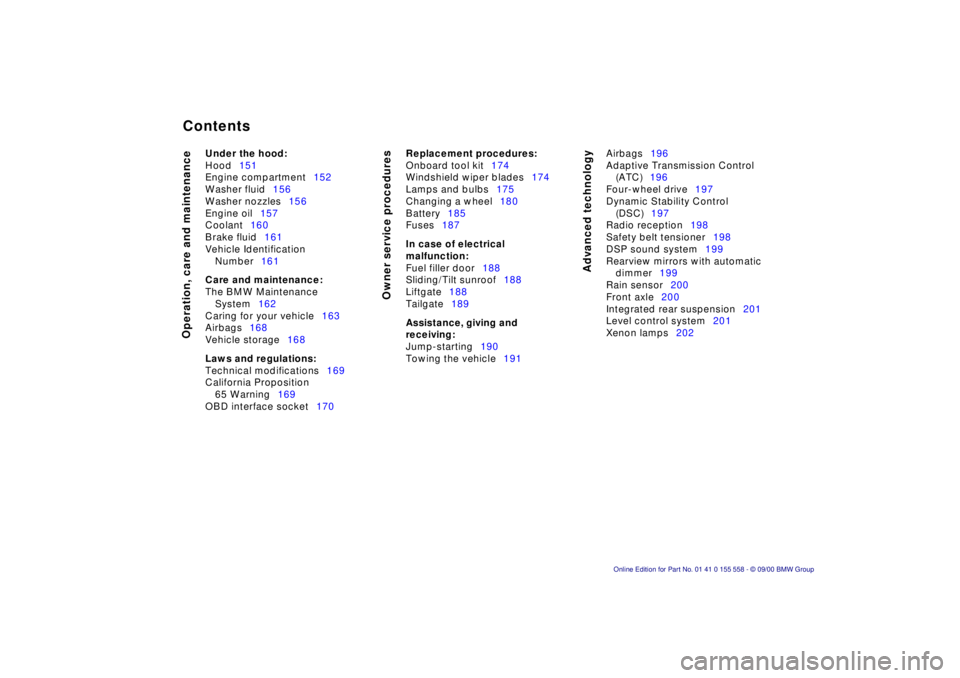
Contents
Operation, care and maintenanceOwner service proceduresAdvanced technology
Under the hood:
Hood 151
Engine compartment 152
Washer fluid 156
Washer nozzles 156
Engine oil 157
Coolant 160
Brake fluid 161
Vehicle Identification Number 161
Care and maintenance:
The BMW Maintenance
System 162
Caring for your vehicle 163
Airbags 168
Vehicle storage 168
Laws and regulations:
Technical modifications 169
California Proposition 65 Warning 169
OBD interface socket 170
Replacement procedures:
Onboard tool kit174
Windshield wiper blades 174
Lamps and bulbs 175
Changing a wheel 180
Battery 185
Fuses 187
In case of electrical
malfunction:
Fuel filler door 188
Sliding/Tilt sunroof 188
Liftgate 188
Tailgate 189
Assistance, giving and
receiving:
Jump-starting 190
Towing the vehicle 191 Airbags
196
Adaptive Transmission Control (ATC) 196
Four-wheel drive 197
Dynamic Stability Control (DSC) 197
Radio reception 198
Safety belt tensioner 198
DSP sound system 199
Rearview mirrors with automatic dimmer 199
Rain sensor 200
Front axle 200
Integrated rear suspension 201
Level control system 201
Xenon lamps 202
Page 19 of 223
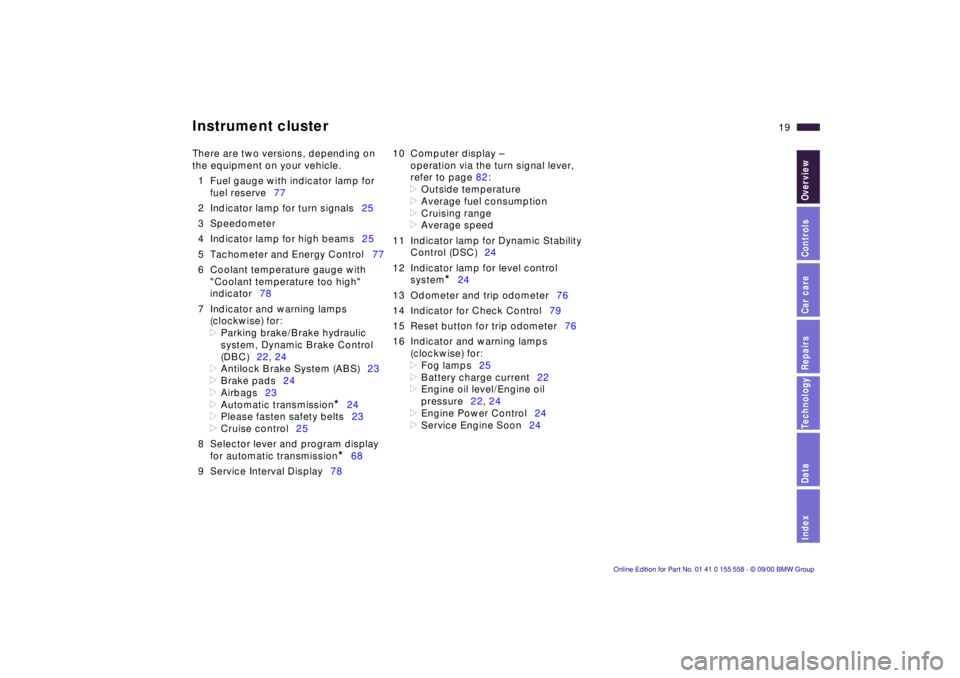
Index
Data
Technology
Repairs
Car care
Controls
Overview
19n
Instrument cluster
There are two versions, depending on
the equipment on your vehicle.
1 Fuel gauge with indicator lamp for fuel reserve 77
2 Indicator lamp for turn signals 25
3 Speedometer
4 Indicator lamp for high beams 25
5 Tachometer and Energy Control 77
6 Coolant temperature gauge with "Coolant temperature too high"
indicator 78
7 Indicator and warning lamps (clockwise) for:
>
Parking brake/Brake hydraulic
system, Dynamic Brake Control
(DBC) 22, 24
>
Antilock Brake System (ABS) 23
>
Brake pads24
>
Airbags23
>
Automatic transmission
*
24
>
Please fasten safety belts 23
>
Cruise control25
8 Selector lever and program display for automatic transmission
*
68
9 Service Interval Display 7810 Computer display –
operation via the turn signal lever,
refer to page 82:
>
Outside temperature
>
Average fuel consumption
>
Cruising range
>
Average speed
11 Indicator lamp for Dynamic Stability Control (DSC) 24
12 Indicator lamp for level control system
*
24
13 Odometer and trip odometer 76
14 Indicator for Check Control 79
15 Reset button for trip odometer 76
16 Indicator and warning lamps (clockwise) for:
>
Fog lamps 25
>
Battery charge current 22
>
Engine oil level/Engine oil
pressure22, 24
>
Engine Power Control 24
>
Service Engine Soon24
Page 78 of 223
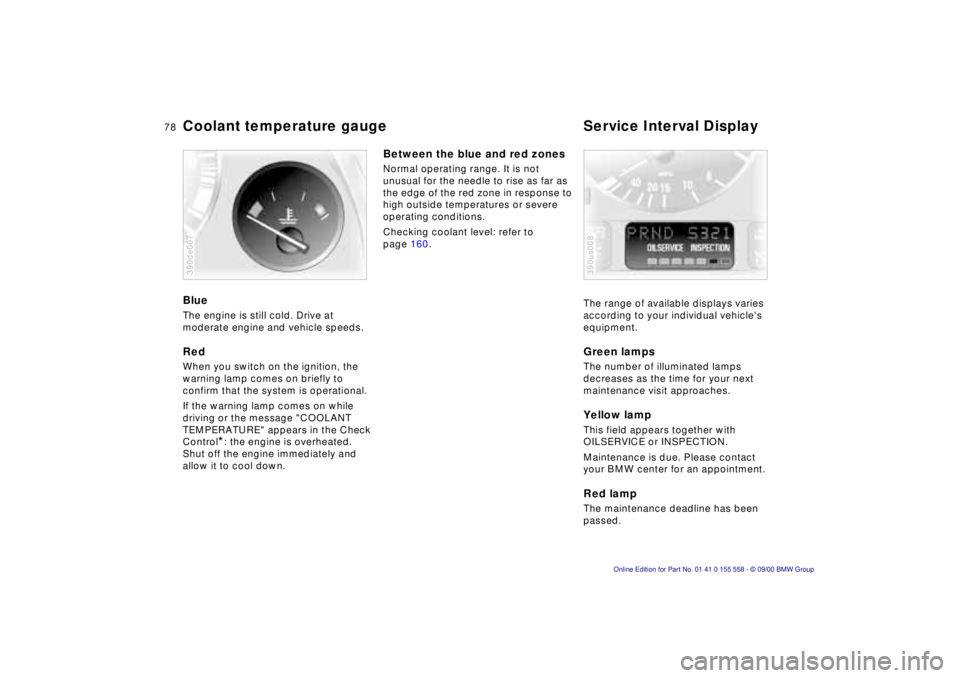
78nCoolant temperature gauge Service Interval Display
Blue
The engine is still cold. Drive at
moderate engine and vehicle speeds.
Red
When you switch on the ignition, the
warning lamp comes on briefly to
confirm that the system is operational.
If the warning lamp comes on while
driving or the message "COOLANT
TEMPERATURE" appears in the Check
Control
*: the engine is overheated.
Shut off the engine immediately and
allow it to cool down.
390de007
Between the blue and red zones
Normal operating range. It is not
unusual for the needle to rise as far as
the edge of the red zone in response to
high outside temperatures or severe
operating conditions.
Checking coolant level: refer to
page 160.
The range of available displays varies
according to your individual vehicle's
equipment.
Green lamps
The number of illuminated lamps
decreases as the time for your next
maintenance visit approaches.
Yellow lamp
This field appears together with
OILSERVICE or INSPECTION.
Maintenance is due. Please contact
your BMW center for an appointment.
Red lamp
The maintenance deadline has been
passed.
390us008
Page 81 of 223
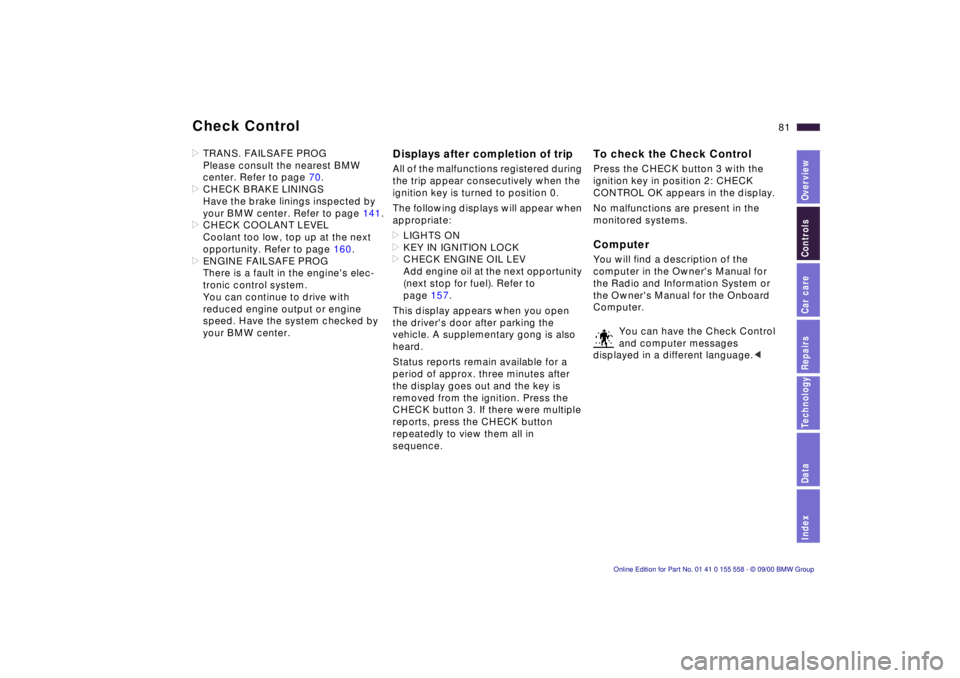
Index
Data
Technology
Repairs
Car care
Controls
Overview
81nCheck Control
>TRANS. FAILSAFE PROG
Please consult the nearest BMW
center. Refer to page 70.
> CHECK BRAKE LININGS
Have the brake linings inspected by
your BMW center. Refer to page 141.
> CHECK COOLANT LEVEL
Coolant too low, top up at the next
opportunity. Refer to page 160.
> ENGINE FAILSAFE PROG
There is a fault in the engine's elec-
tronic control system.
You can continue to drive with
reduced engine output or engine
speed. Have the system checked by
your BMW center. Displays after completion of trip
All of the malfunctions registered during
the trip appear consecutively when the
ignition key is turned to position 0.
The following displays will appear when
appropriate:
>LIGHTS ON
> KEY IN IGNITION LOCK
> CHECK ENGINE OIL LEV
Add engine oil at the next opportunity
(next stop for fuel). Refer to
page 157.
This display appears when you open
the driver's door after parking the
vehicle. A supplementary gong is also
heard.
Status reports remain available for a
period of approx. three minutes after
the display goes out and the key is
removed from the ignition. Press the
CHECK button 3. If there were multiple
reports, press the CHECK button
repeatedly to view them all in
sequence.
To check the Check Control
Press the CHECK button 3 with the
ignition key in position 2: CHECK
CONTROL OK appears in the display.
No malfunctions are present in the
monitored systems.
Computer
You will find a description of the
computer in the Owner's Manual for
the Radio and Information System or
the Owner's Manual for the Onboard
Computer.
You can have the Check Control
and computer messages
displayed in a different language. <
Page 133 of 223
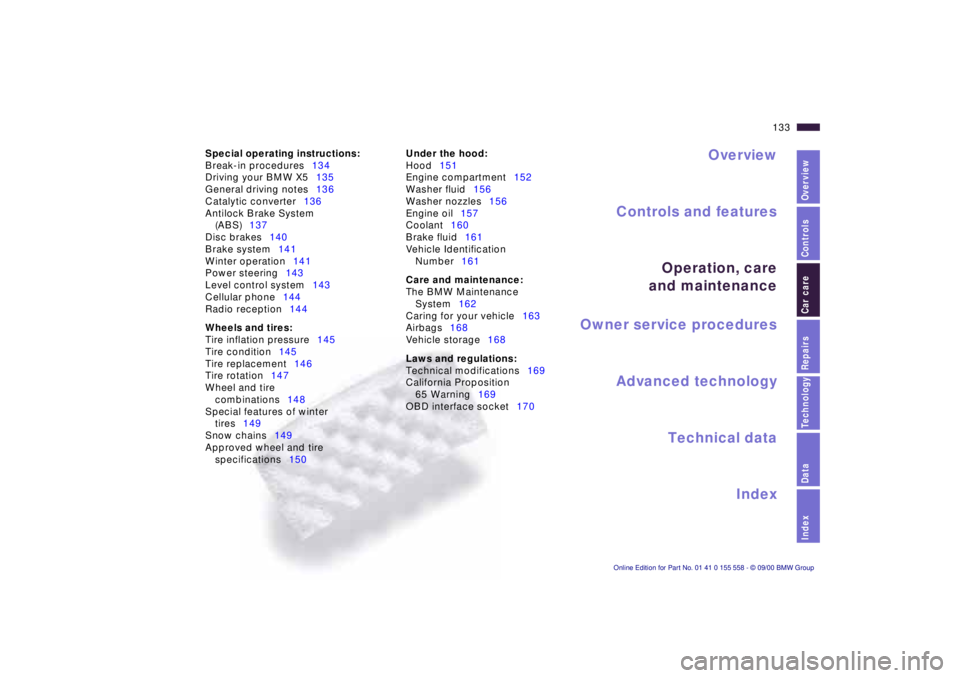
IndexDataTechnologyRepairsCar careControlsOverview
Overview
Controls and features
Operation, care
and maintenance
Owner service procedures
Technical data
Index Advanced technology
133n
Under the hood:
Hood151
Engine compartment152
Washer fluid156
Washer nozzles156
Engine oil157
Coolant160
Brake fluid161
Vehicle Identification
Number161
Care and maintenance:
The BMW Maintenance
System162
Caring for your vehicle163
Airbags168
Vehicle storage168
Laws and regulations:
Technical modifications169
California Proposition
65 Warning169
OBD interface socket170
Car care Special operating instructions:
Break-in procedures134
Driving your BMW X5135
General driving notes136
Catalytic converter136
Antilock Brake System
(ABS)137
Disc brakes140
Brake system141
Winter operation141
Power steering143
Level control system143
Cellular phone144
Radio reception144
Wheels and tires:
Tire inflation pressure145
Tire condition145
Tire replacement146
Tire rotation147
Wheel and tire
combinations148
Special features of winter
tires149
Snow chains149
Approved wheel and tire
specifications150
Page 135 of 223

IndexDataTechnologyRepairsCar careControlsOverview
135n
Driving your BMW X5 Your BMW is right at home on all roads
and byways – even where the pavement
ends. It combines permanent four-
wheel drive with the agility of a typical
passenger car. On bad roadsWhen you are driving on bad roads,
there are a few points which you should
strictly heed — for your own safety, for
that of your passengers, and for the
safekeeping of the vehicle:
>Familiarize yourself with the vehicle
before you begin driving. Do not take
risks with the vehicle under any
circumstances.
>Always adapt vehicle speed to road
conditions – the steeper and more
uneven the road surface is, the
slower the vehicle's speed should be.
>You can operate your vehicle on
uphill and downhill gradients with a
maximum slope of 50 %. If you intend
to drive on either an uphill or downhill
gradient of this steepness, check to
be sure in advance that the engine oil
and coolant levels are both near the
"MAX" mark. Refer to pages 157
and 160.
When driving down steep slopes, use
the Hill Descent Control (HDC). Refer
to page 95. Starting from a full stop is possible on
uphill gradients of up to 32 %.
The permitted side tilt is also 50 %.
>While driving, watch carefully for
obstacles such as rocks or holes. Try
to avoid these obstacles whenever
possible.
>On hill crests and bumpy roads, for
example, be careful to prevent the
body from "bottoming" (contact
between the body and the ground).
The ground clearance of the vehicle
is:
– 8 inches (200 mm) with up to four
passengers
– 7 inches (180 mm) fully loaded.
>Do not drive in water that is deeper
than 20 inches (50 cm). If you must
drive through water up to that depth,
drive at a walking speed and do not
stop.
After leaving the water, press on the
footbrake gently several times while
driving at a low speed. The brake
applications will help to dry the
brakes, thus preventing a reduction in
braking performance caused by the
moisture.
Back onto the paved road In recommending that you observe the
following points after driving on adverse
road surfaces, it is not as a "beauty
treatment" for your BMW. Instead, it is
intended for the maintenance of driving
safety:
>Clean accumulations of dirt from the
body and check the undercarriage for
damage.
>Clean mud, snow, ice and other
materials from the wheels and tires.
Check the tires for damage.
>Check to determine whether rocks,
gravel or accumulations of dirt on the
brake discs and calipers could influ-
ence braking performance. Remove
all such foreign objects.
>In order to clean the brake discs,
apply the footbrake gently several
times while driving at a low speed. Be
sure that following traffic is not
endangered by this.
>For cleaning the parking brake, apply
the lever slightly at approx. 25 mph
(40 km/h) and continue to drive for
approx. 200 yards (200 meters),
provided that traffic conditions allow
you to do so.
Page 141 of 223
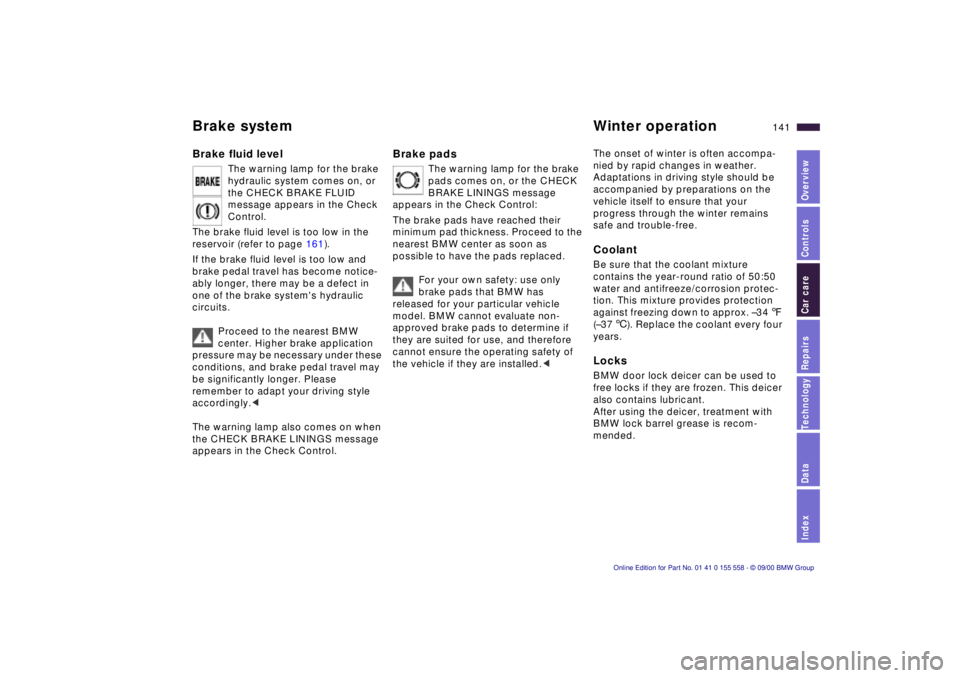
IndexDataTechnologyRepairsCar careControlsOverview
141n
Brake system Winter operationBrake fluid level
The warning lamp for the brake
hydraulic system comes on, or
the CHECK BRAKE FLUID
message appears in the Check
Control.
The brake fluid level is too low in the
reservoir (refer to page 161).
If the brake fluid level is too low and
brake pedal travel has become notice-
ably longer, there may be a defect in
one of the brake system's hydraulic
circuits.
Proceed to the nearest BMW
center. Higher brake application
pressure may be necessary under these
conditions, and brake pedal travel may
be significantly longer. Please
remember to adapt your driving style
accordingly.<
The warning lamp also comes on when
the CHECK BRAKE LININGS message
appears in the Check Control.
Brake pads
The warning lamp for the brake
pads comes on, or the CHECK
BRAKE LININGS message
appears in the Check Control:
The brake pads have reached their
minimum pad thickness. Proceed to the
nearest BMW center as soon as
possible to have the pads replaced.
For your own safety: use only
brake pads that BMW has
released for your particular vehicle
model. BMW cannot evaluate non-
approved brake pads to determine if
they are suited for use, and therefore
cannot ensure the operating safety of
the vehicle if they are installed.<
The onset of winter is often accompa-
nied by rapid changes in weather.
Adaptations in driving style should be
accompanied by preparations on the
vehicle itself to ensure that your
progress through the winter remains
safe and trouble-free. CoolantBe sure that the coolant mixture
contains the year-round ratio of 50:50
water and antifreeze/corrosion protec-
tion. This mixture provides protection
against freezing down to approx. –347
(–376). Replace the coolant every four
years. LocksBMW door lock deicer can be used to
free locks if they are frozen. This deicer
also contains lubricant.
After using the deicer, treatment with
BMW lock barrel grease is recom-
mended.
Page 160 of 223
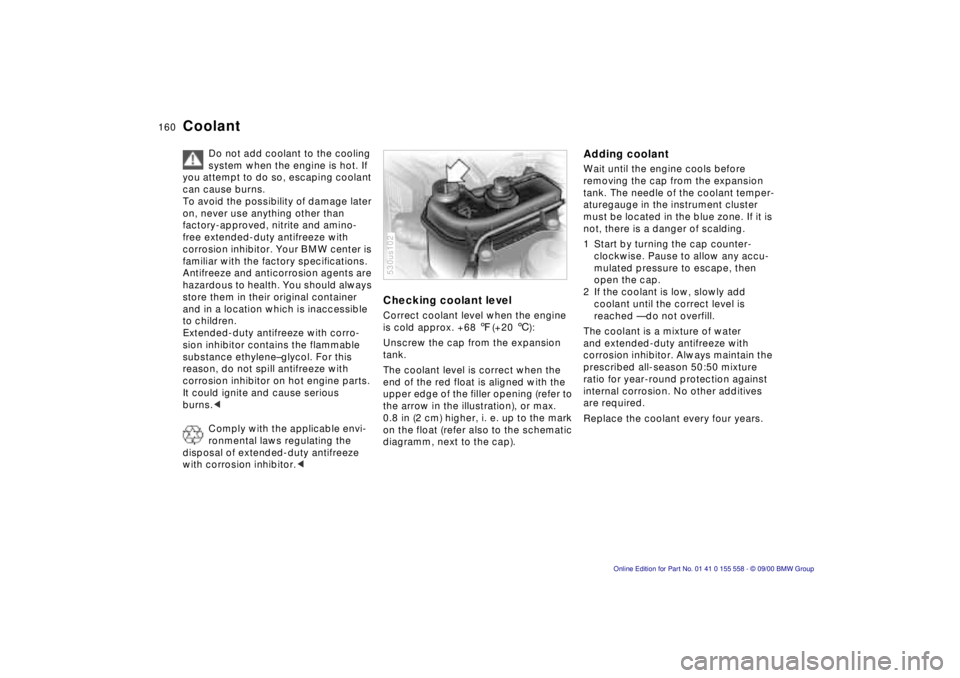
160n
Coolant
Do not add coolant to the cooling
system when the engine is hot. If
you attempt to do so, escaping coolant
can cause burns.
To avoid the possibility of damage later
on, never use anything other than
factory-approved, nitrite and amino-
free extended-duty antifreeze with
corrosion inhibitor. Your BMW center is
familiar with the factory specifications.
Antifreeze and anticorrosion agents are
hazardous to health. You should always
store them in their original container
and in a location which is inaccessible
to children.
Extended-duty antifreeze with corro-
sion inhibitor contains the flammable
substance ethylene–glycol. For this
reason, do not spill antifreeze with
corrosion inhibitor on hot engine parts.
It could ignite and cause serious
burns.<
Comply with the applicable envi-
ronmental laws regulating the
disposal of extended-duty antifreeze
with corrosion inhibitor.<
Checking coolant levelCorrect coolant level when the engine
is cold approx. +68 7(+20 6):
Unscrew the cap from the expansion
tank.
The coolant level is correct when the
end of the red float is aligned with the
upper edge of the filler opening (refer to
the arrow in the illustration), or max.
0.8 in (2 cm) higher, i. e. up to the mark
on the float (refer also to the schematic
diagramm, next to the cap).530us102
Adding coolant Wait until the engine cools before
removing the cap from the expansion
tank. The needle of the coolant temper-
aturegauge in the instrument cluster
must be located in the blue zone. If it is
not, there is a danger of scalding.
1 Start by turning the cap counter-
clockwise. Pause to allow any accu-
mulated pressure to escape, then
open the cap.
2 If the coolant is low, slowly add
coolant until the correct level is
reached — do not overfill.
The coolant is a mixture of water
and extended-duty antifreeze with
corrosion inhibitor. Always maintain the
prescribed all-season 50:50 mixture
ratio for year-round protection against
internal corrosion. No other additives
are required.
Replace the coolant every four years.
Page 215 of 223
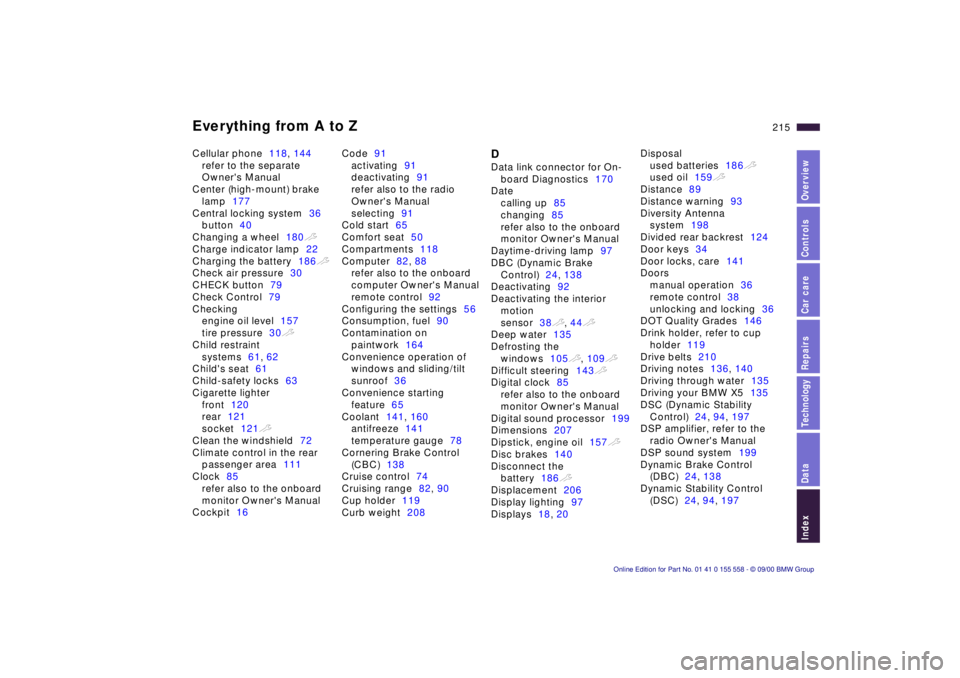
Everything from A to Z215n
Index
Data
Technology
Repairs
Car care
Controls
Overview
Cellular phone 118, 144
refer to the separate
Owner's Manual
Center (high-mount) brake lamp 177
Central locking system 36
button 40
Changing a wheel 180t
Charge indicator lamp 22
Charging the battery 186t
Check air pressure 30
CHECK button 79
Check Control 79
Checking engine oil level 157
tire pressure 30t
Child restraint systems 61, 62
Child's seat 61
Child-safety locks 63
Cigarette lighter front 120
rear 121
socket 121t
Clean the windshield 72
Climate control in the rear passenger area 111
Clock 85
refer also to the onboard
monitor Owner's Manual
Cockpit 16 Code
91
activating 91
deactivating 91
refer also to the radio
Owner's Manual
selecting 91
Cold start 65
Comfort seat 50
Compartments 118
Computer 82, 88
refer also to the onboard
computer Owner's Manual
remote control 92
Configuring the settings 56
Consumption, fuel 90
Contamination on paintwork 164
Convenience operation of windows and sliding/tilt
sunroof 36
Convenience starting feature 65
Coolant 141, 160
antifreeze 141
temperature gauge 78
Cornering Brake Control (CBC) 138
Cruise control 74
Cruising range 82, 90
Cup holder 119
Curb weight 208D
Data link connector for On-
board Diagnostics 170
Date calling up 85
changing 85
refer also to the onboard
monitor Owner's Manual
Daytime-driving lamp 97
DBC (Dynamic Brake Control) 24, 138
Deactivating 92
Deactivating the interior motion
sensor 38t , 44 t
Deep water 135
Defrosting the windows 105t, 109 t
Difficult steering 143t
Digital clock 85
refer also to the onboard
monitor Owner's Manual
Digital sound processor 199
Dimensions 207
Dipstick, engine oil 157t
Disc brakes 140
Disconnect the battery 186t
Displacement 206
Display lighting 97
Displays 18, 20 Disposal
used batteries 186t
used oil 159t
Distance 89
Distance warning 93
Diversity Antenna system 198
Divided rear backrest 124
Door keys 34
Door locks, care 141
Doors manual operation 36
remote control 38
unlocking and locking 36
DOT Quality Grades 146
Drink holder, refer to cup holder 119
Drive belts 210
Driving notes 136, 140
Driving through water 135
Driving your BMW X5 135
DSC (Dynamic Stability Control) 24, 94 , 197
DSP amplifier, refer to the radio Owner's Manual
DSP sound system 199
Dynamic Brake Control (DBC) 24, 138
Dynamic Stability Control (DSC) 24, 94 , 197
Page 216 of 223
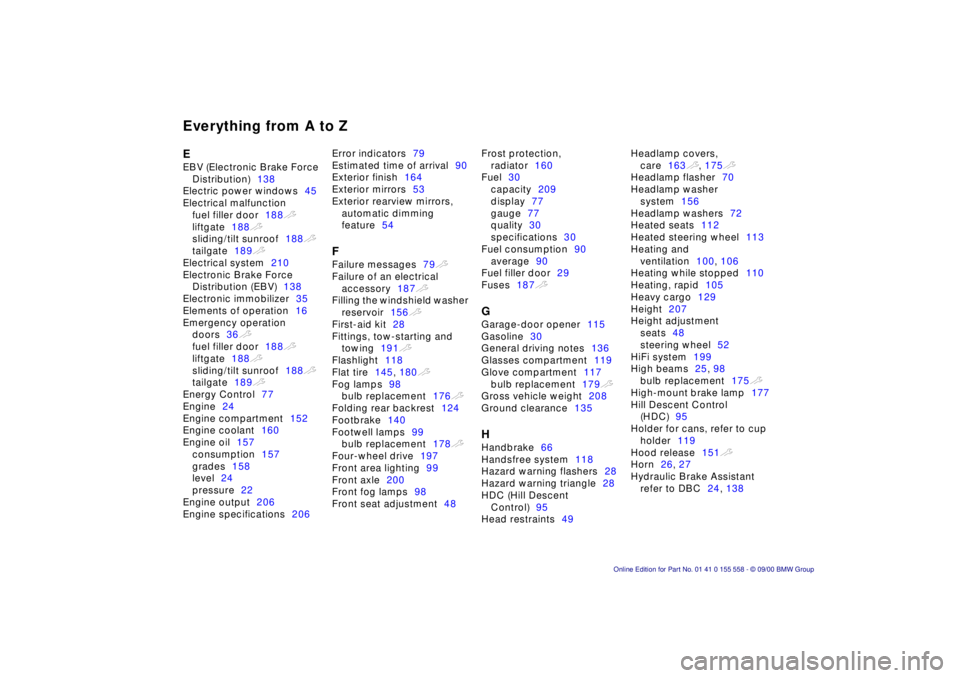
Everything from A to Z
E
EBV (Electronic Brake Force Distribution) 138
Electric power windows 45
Electrical malfunction fuel filler door 188t
liftgate 188t
sliding/tilt sunroof 188t
tailgate 189t
Electrical system 210
Electronic Brake Force Distribution (EBV) 138
Electronic immobilizer 35
Elements of operation 16
Emergency operation doors 36t
fuel filler door 188t
liftgate 188t
sliding/tilt sunroof 188t
tailgate 189t
Energy Control 77
Engine 24
Engine compartment 152
Engine coolant 160
Engine oil 157
consumption 157
grades 158
level 24
pressure 22
Engine output 206
Engine specifications 206Error indicators
79
Estimated time of arrival 90
Exterior finish 164
Exterior mirrors 53
Exterior rearview mirrors, automatic dimming
feature 54
F
Failure messages 79t
Failure of an electrical accessory 187t
Filling the windshield washer reservoir 156t
First-aid kit 28
Fittings, tow-starting and towing 191t
Flashlight 118
Flat tire 145, 180 t
Fog lamps 98
bulb replacement 176t
Folding rear backrest 124
Footbrake 140
Footwell lamps 99
bulb replacement 178t
Four-wheel drive 197
Front area lighting 99
Front axle 200
Front fog lamps 98
Front seat adjustment 48Frost protection,
radiator 160
Fuel 30
capacity 209
display 77
gauge 77
quality 30
specifications 30
Fuel consumption 90
average 90
Fuel filler door 29
Fuses 187t
G
Garage-door opener 115
Gasoline 30
General driving notes 136
Glasses compartment 119
Glove compartment 117
bulb replacement 179t
Gross vehicle weight 208
Ground clearance 135
H
Handbrake66
Handsfree system 118
Hazard warning flashers 28
Hazard warning triangle 28
HDC (Hill Descent Control) 95
Head restraints 49Headlamp covers,
care 163t, 175 t
Headlamp flasher 70
Headlamp washer system 156
Headlamp washers 72
Heated seats 112
Heated steering wheel 113
Heating and ventilation 100, 106
Heating while stopped 110
Heating, rapid 105
Heavy cargo 129
Height 207
Height adjustment seats 48
steering wheel 52
HiFi system 199
High beams 25, 98
bulb replacement 175t
High-mount brake lamp 177
Hill Descent Control (HDC) 95
Holder for cans, refer to cup holder 119
Hood release 151t
Horn 26, 27
Hydraulic Brake Assistant refer to DBC 24, 138